Psychoactive Substances and Mental Health
VerifiedAdded on 2023/06/08
|9
|2637
|256
AI Summary
This report reflects on a case study of mental health issue, in which a psychiatric counselor/ Assessor (Mark) is conducting a follow up session with the subject (Gavin). The report discusses the use of the ASSIST screening tool to identify the signs of problematic substance use by Gavin, the impact of substance abuse on his health and lifestyle, and the level of engagement between Gavin and Mark.
Contribute Materials
Your contribution can guide someone’s learning journey. Share your
documents today.
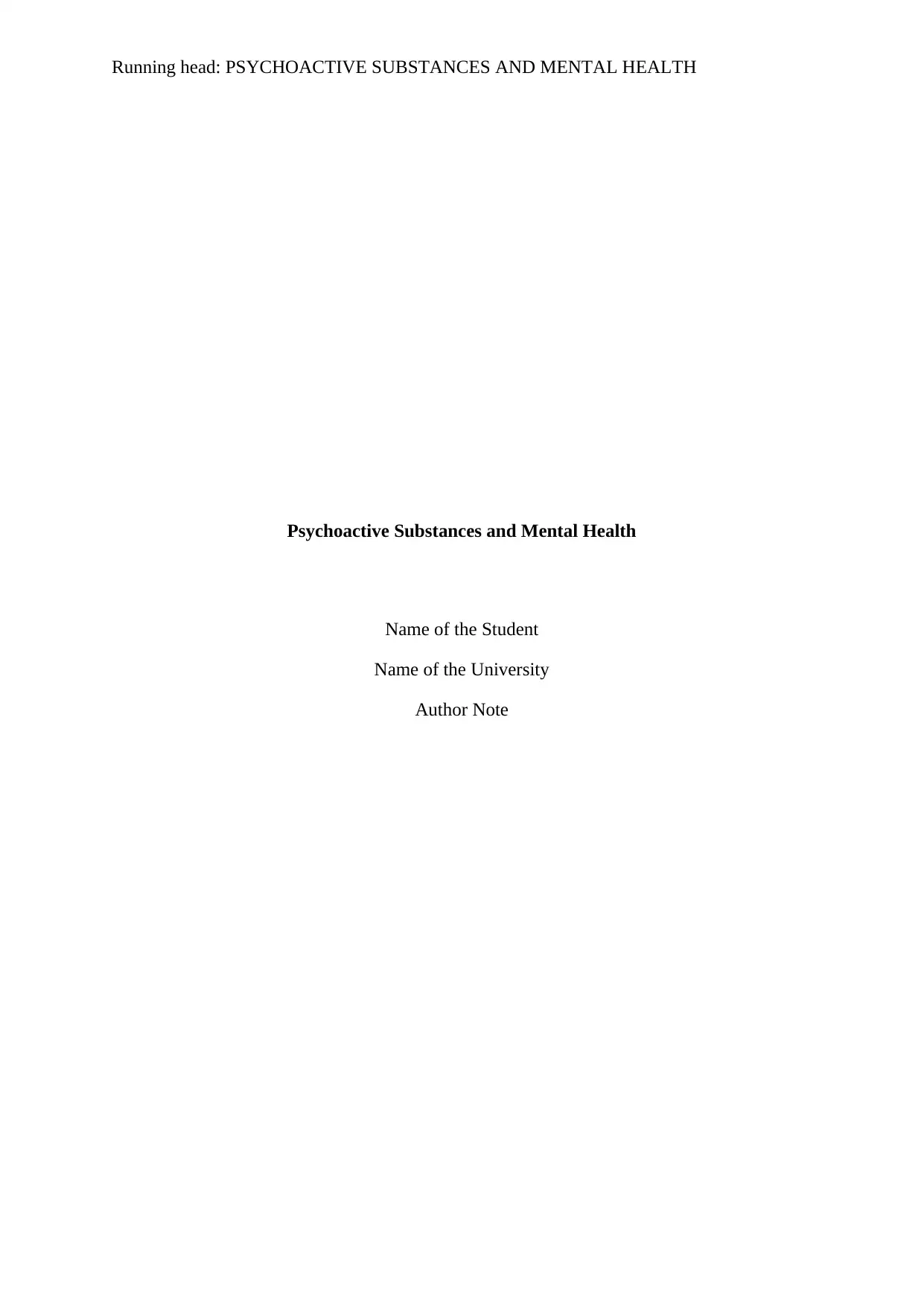
Running head: PSYCHOACTIVE SUBSTANCES AND MENTAL HEALTH
Psychoactive Substances and Mental Health
Name of the Student
Name of the University
Author Note
Psychoactive Substances and Mental Health
Name of the Student
Name of the University
Author Note
Secure Best Marks with AI Grader
Need help grading? Try our AI Grader for instant feedback on your assignments.
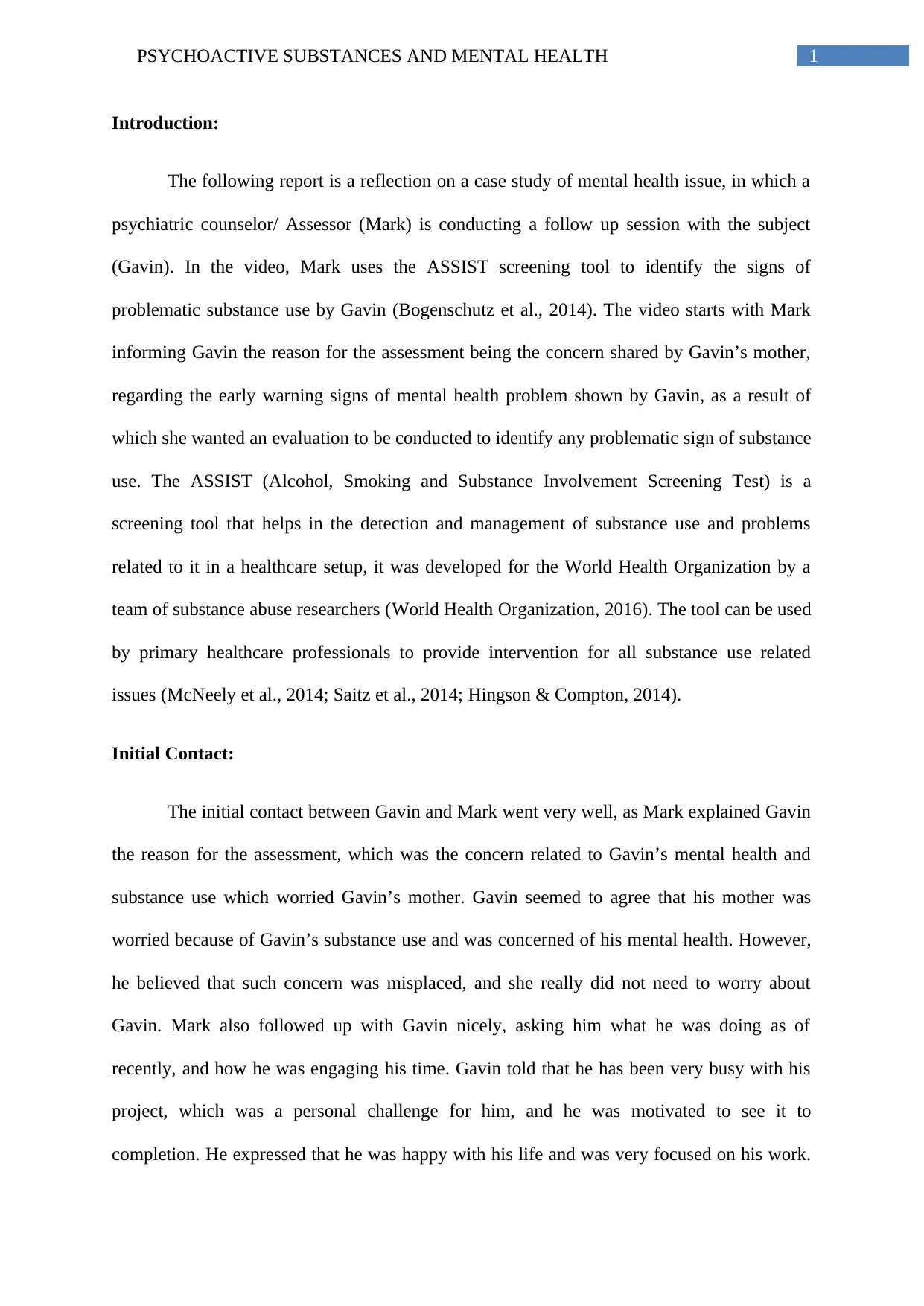
1PSYCHOACTIVE SUBSTANCES AND MENTAL HEALTH
Introduction:
The following report is a reflection on a case study of mental health issue, in which a
psychiatric counselor/ Assessor (Mark) is conducting a follow up session with the subject
(Gavin). In the video, Mark uses the ASSIST screening tool to identify the signs of
problematic substance use by Gavin (Bogenschutz et al., 2014). The video starts with Mark
informing Gavin the reason for the assessment being the concern shared by Gavin’s mother,
regarding the early warning signs of mental health problem shown by Gavin, as a result of
which she wanted an evaluation to be conducted to identify any problematic sign of substance
use. The ASSIST (Alcohol, Smoking and Substance Involvement Screening Test) is a
screening tool that helps in the detection and management of substance use and problems
related to it in a healthcare setup, it was developed for the World Health Organization by a
team of substance abuse researchers (World Health Organization, 2016). The tool can be used
by primary healthcare professionals to provide intervention for all substance use related
issues (McNeely et al., 2014; Saitz et al., 2014; Hingson & Compton, 2014).
Initial Contact:
The initial contact between Gavin and Mark went very well, as Mark explained Gavin
the reason for the assessment, which was the concern related to Gavin’s mental health and
substance use which worried Gavin’s mother. Gavin seemed to agree that his mother was
worried because of Gavin’s substance use and was concerned of his mental health. However,
he believed that such concern was misplaced, and she really did not need to worry about
Gavin. Mark also followed up with Gavin nicely, asking him what he was doing as of
recently, and how he was engaging his time. Gavin told that he has been very busy with his
project, which was a personal challenge for him, and he was motivated to see it to
completion. He expressed that he was happy with his life and was very focused on his work.
Introduction:
The following report is a reflection on a case study of mental health issue, in which a
psychiatric counselor/ Assessor (Mark) is conducting a follow up session with the subject
(Gavin). In the video, Mark uses the ASSIST screening tool to identify the signs of
problematic substance use by Gavin (Bogenschutz et al., 2014). The video starts with Mark
informing Gavin the reason for the assessment being the concern shared by Gavin’s mother,
regarding the early warning signs of mental health problem shown by Gavin, as a result of
which she wanted an evaluation to be conducted to identify any problematic sign of substance
use. The ASSIST (Alcohol, Smoking and Substance Involvement Screening Test) is a
screening tool that helps in the detection and management of substance use and problems
related to it in a healthcare setup, it was developed for the World Health Organization by a
team of substance abuse researchers (World Health Organization, 2016). The tool can be used
by primary healthcare professionals to provide intervention for all substance use related
issues (McNeely et al., 2014; Saitz et al., 2014; Hingson & Compton, 2014).
Initial Contact:
The initial contact between Gavin and Mark went very well, as Mark explained Gavin
the reason for the assessment, which was the concern related to Gavin’s mental health and
substance use which worried Gavin’s mother. Gavin seemed to agree that his mother was
worried because of Gavin’s substance use and was concerned of his mental health. However,
he believed that such concern was misplaced, and she really did not need to worry about
Gavin. Mark also followed up with Gavin nicely, asking him what he was doing as of
recently, and how he was engaging his time. Gavin told that he has been very busy with his
project, which was a personal challenge for him, and he was motivated to see it to
completion. He expressed that he was happy with his life and was very focused on his work.

2PSYCHOACTIVE SUBSTANCES AND MENTAL HEALTH
However, there seemed to be an element of sarcasm in how Gavin replied, but he honestly
replied mark, for example Gavin clearly commented that the TAFE course was not the best
and the teachers were just pathetic. It seemed like Mark was able to develop an honest
communication with Gavin (Suffoletto et al., 2015).
Rapport building:
Mark was able to develop rapport with Gavin, going through his experiences with the
TAFE course, and his project. Gavin shared a lot of information with mark regarding his
project, of which he was very secretive about, and after initial sense of apprehension to share
such details. Gavin’s initial response of being asked details about his project was of
incredulity and mistrust, which Mark was able to overcome in due course, and thus maintain
an open and honest conversation. This showed that a significant amount of rapport did
develop between Gavin and Mark, and Gavin became more and more comfortable to share
his thoughts and plans with Mark. This also showed that a therapeutic relation was being
developed and Mark was able to get some very important points answered by Gavin, such as
his willingness to smoke cannabis to help him ‘open his mind’ and ‘think differently’ which
was very necessary for Mark to complete his project. Gavin showed a sense of pride in his
project, stating that it would have immense impact on the lives of people and ‘change the way
we see the world’ which showed that he was feeling at ease in the conversation (Humeniuk et
al., 2016; Patson et al., 2017).
Interviewee’s readiness for change:
Initially, Gavin was not very open or willing towards the suggestion to stop smoking
cannabis. His unwillingness was mainly accredited to his desire to complete his project,
which needed a significant mental capacity and the ability to think out of box, and in an open
minded manner. It was evident that Gavin was used to smoking cannabis during such
However, there seemed to be an element of sarcasm in how Gavin replied, but he honestly
replied mark, for example Gavin clearly commented that the TAFE course was not the best
and the teachers were just pathetic. It seemed like Mark was able to develop an honest
communication with Gavin (Suffoletto et al., 2015).
Rapport building:
Mark was able to develop rapport with Gavin, going through his experiences with the
TAFE course, and his project. Gavin shared a lot of information with mark regarding his
project, of which he was very secretive about, and after initial sense of apprehension to share
such details. Gavin’s initial response of being asked details about his project was of
incredulity and mistrust, which Mark was able to overcome in due course, and thus maintain
an open and honest conversation. This showed that a significant amount of rapport did
develop between Gavin and Mark, and Gavin became more and more comfortable to share
his thoughts and plans with Mark. This also showed that a therapeutic relation was being
developed and Mark was able to get some very important points answered by Gavin, such as
his willingness to smoke cannabis to help him ‘open his mind’ and ‘think differently’ which
was very necessary for Mark to complete his project. Gavin showed a sense of pride in his
project, stating that it would have immense impact on the lives of people and ‘change the way
we see the world’ which showed that he was feeling at ease in the conversation (Humeniuk et
al., 2016; Patson et al., 2017).
Interviewee’s readiness for change:
Initially, Gavin was not very open or willing towards the suggestion to stop smoking
cannabis. His unwillingness was mainly accredited to his desire to complete his project,
which needed a significant mental capacity and the ability to think out of box, and in an open
minded manner. It was evident that Gavin was used to smoking cannabis during such
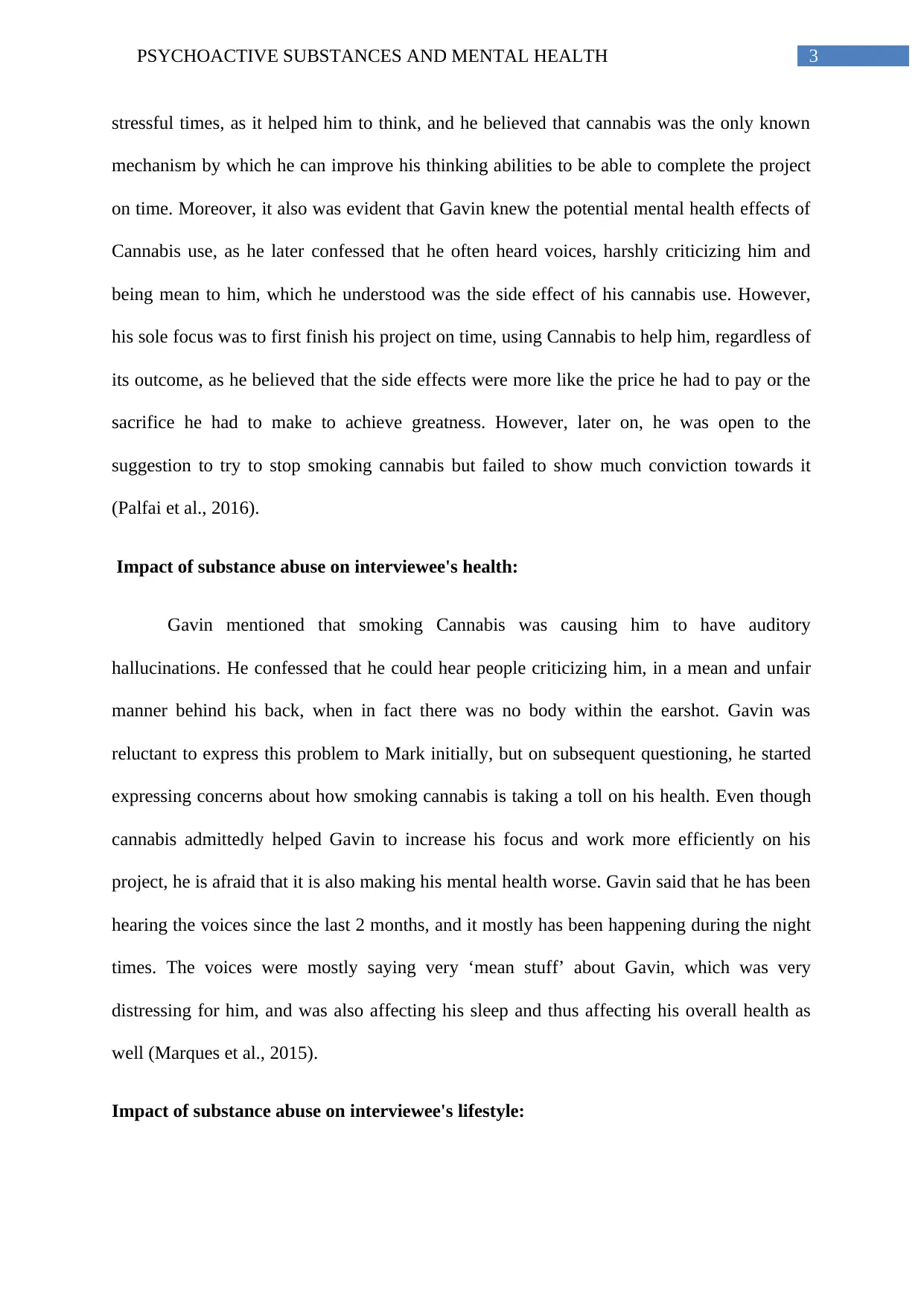
3PSYCHOACTIVE SUBSTANCES AND MENTAL HEALTH
stressful times, as it helped him to think, and he believed that cannabis was the only known
mechanism by which he can improve his thinking abilities to be able to complete the project
on time. Moreover, it also was evident that Gavin knew the potential mental health effects of
Cannabis use, as he later confessed that he often heard voices, harshly criticizing him and
being mean to him, which he understood was the side effect of his cannabis use. However,
his sole focus was to first finish his project on time, using Cannabis to help him, regardless of
its outcome, as he believed that the side effects were more like the price he had to pay or the
sacrifice he had to make to achieve greatness. However, later on, he was open to the
suggestion to try to stop smoking cannabis but failed to show much conviction towards it
(Palfai et al., 2016).
Impact of substance abuse on interviewee's health:
Gavin mentioned that smoking Cannabis was causing him to have auditory
hallucinations. He confessed that he could hear people criticizing him, in a mean and unfair
manner behind his back, when in fact there was no body within the earshot. Gavin was
reluctant to express this problem to Mark initially, but on subsequent questioning, he started
expressing concerns about how smoking cannabis is taking a toll on his health. Even though
cannabis admittedly helped Gavin to increase his focus and work more efficiently on his
project, he is afraid that it is also making his mental health worse. Gavin said that he has been
hearing the voices since the last 2 months, and it mostly has been happening during the night
times. The voices were mostly saying very ‘mean stuff’ about Gavin, which was very
distressing for him, and was also affecting his sleep and thus affecting his overall health as
well (Marques et al., 2015).
Impact of substance abuse on interviewee's lifestyle:
stressful times, as it helped him to think, and he believed that cannabis was the only known
mechanism by which he can improve his thinking abilities to be able to complete the project
on time. Moreover, it also was evident that Gavin knew the potential mental health effects of
Cannabis use, as he later confessed that he often heard voices, harshly criticizing him and
being mean to him, which he understood was the side effect of his cannabis use. However,
his sole focus was to first finish his project on time, using Cannabis to help him, regardless of
its outcome, as he believed that the side effects were more like the price he had to pay or the
sacrifice he had to make to achieve greatness. However, later on, he was open to the
suggestion to try to stop smoking cannabis but failed to show much conviction towards it
(Palfai et al., 2016).
Impact of substance abuse on interviewee's health:
Gavin mentioned that smoking Cannabis was causing him to have auditory
hallucinations. He confessed that he could hear people criticizing him, in a mean and unfair
manner behind his back, when in fact there was no body within the earshot. Gavin was
reluctant to express this problem to Mark initially, but on subsequent questioning, he started
expressing concerns about how smoking cannabis is taking a toll on his health. Even though
cannabis admittedly helped Gavin to increase his focus and work more efficiently on his
project, he is afraid that it is also making his mental health worse. Gavin said that he has been
hearing the voices since the last 2 months, and it mostly has been happening during the night
times. The voices were mostly saying very ‘mean stuff’ about Gavin, which was very
distressing for him, and was also affecting his sleep and thus affecting his overall health as
well (Marques et al., 2015).
Impact of substance abuse on interviewee's lifestyle:
Secure Best Marks with AI Grader
Need help grading? Try our AI Grader for instant feedback on your assignments.
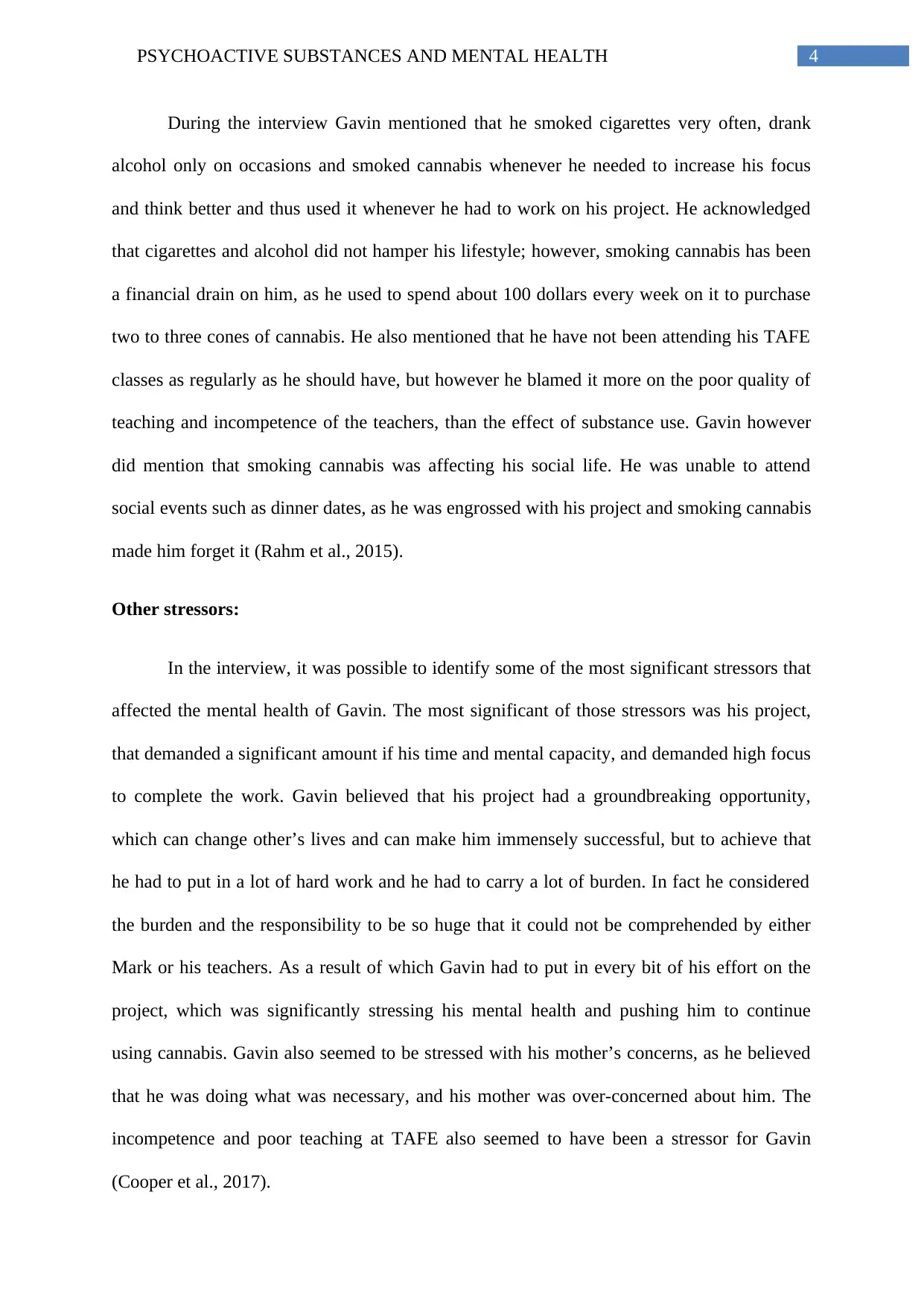
4PSYCHOACTIVE SUBSTANCES AND MENTAL HEALTH
During the interview Gavin mentioned that he smoked cigarettes very often, drank
alcohol only on occasions and smoked cannabis whenever he needed to increase his focus
and think better and thus used it whenever he had to work on his project. He acknowledged
that cigarettes and alcohol did not hamper his lifestyle; however, smoking cannabis has been
a financial drain on him, as he used to spend about 100 dollars every week on it to purchase
two to three cones of cannabis. He also mentioned that he have not been attending his TAFE
classes as regularly as he should have, but however he blamed it more on the poor quality of
teaching and incompetence of the teachers, than the effect of substance use. Gavin however
did mention that smoking cannabis was affecting his social life. He was unable to attend
social events such as dinner dates, as he was engrossed with his project and smoking cannabis
made him forget it (Rahm et al., 2015).
Other stressors:
In the interview, it was possible to identify some of the most significant stressors that
affected the mental health of Gavin. The most significant of those stressors was his project,
that demanded a significant amount if his time and mental capacity, and demanded high focus
to complete the work. Gavin believed that his project had a groundbreaking opportunity,
which can change other’s lives and can make him immensely successful, but to achieve that
he had to put in a lot of hard work and he had to carry a lot of burden. In fact he considered
the burden and the responsibility to be so huge that it could not be comprehended by either
Mark or his teachers. As a result of which Gavin had to put in every bit of his effort on the
project, which was significantly stressing his mental health and pushing him to continue
using cannabis. Gavin also seemed to be stressed with his mother’s concerns, as he believed
that he was doing what was necessary, and his mother was over-concerned about him. The
incompetence and poor teaching at TAFE also seemed to have been a stressor for Gavin
(Cooper et al., 2017).
During the interview Gavin mentioned that he smoked cigarettes very often, drank
alcohol only on occasions and smoked cannabis whenever he needed to increase his focus
and think better and thus used it whenever he had to work on his project. He acknowledged
that cigarettes and alcohol did not hamper his lifestyle; however, smoking cannabis has been
a financial drain on him, as he used to spend about 100 dollars every week on it to purchase
two to three cones of cannabis. He also mentioned that he have not been attending his TAFE
classes as regularly as he should have, but however he blamed it more on the poor quality of
teaching and incompetence of the teachers, than the effect of substance use. Gavin however
did mention that smoking cannabis was affecting his social life. He was unable to attend
social events such as dinner dates, as he was engrossed with his project and smoking cannabis
made him forget it (Rahm et al., 2015).
Other stressors:
In the interview, it was possible to identify some of the most significant stressors that
affected the mental health of Gavin. The most significant of those stressors was his project,
that demanded a significant amount if his time and mental capacity, and demanded high focus
to complete the work. Gavin believed that his project had a groundbreaking opportunity,
which can change other’s lives and can make him immensely successful, but to achieve that
he had to put in a lot of hard work and he had to carry a lot of burden. In fact he considered
the burden and the responsibility to be so huge that it could not be comprehended by either
Mark or his teachers. As a result of which Gavin had to put in every bit of his effort on the
project, which was significantly stressing his mental health and pushing him to continue
using cannabis. Gavin also seemed to be stressed with his mother’s concerns, as he believed
that he was doing what was necessary, and his mother was over-concerned about him. The
incompetence and poor teaching at TAFE also seemed to have been a stressor for Gavin
(Cooper et al., 2017).
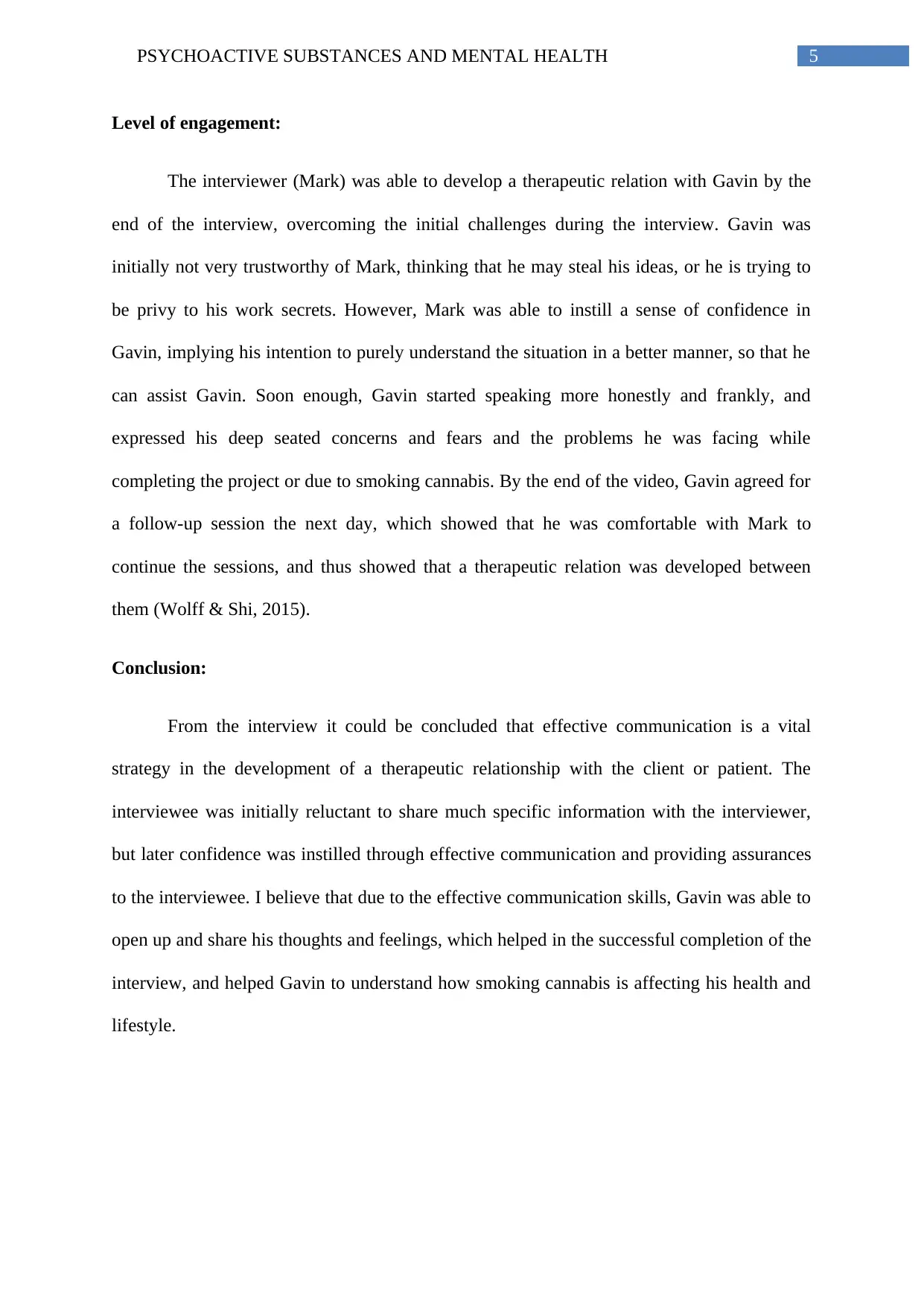
5PSYCHOACTIVE SUBSTANCES AND MENTAL HEALTH
Level of engagement:
The interviewer (Mark) was able to develop a therapeutic relation with Gavin by the
end of the interview, overcoming the initial challenges during the interview. Gavin was
initially not very trustworthy of Mark, thinking that he may steal his ideas, or he is trying to
be privy to his work secrets. However, Mark was able to instill a sense of confidence in
Gavin, implying his intention to purely understand the situation in a better manner, so that he
can assist Gavin. Soon enough, Gavin started speaking more honestly and frankly, and
expressed his deep seated concerns and fears and the problems he was facing while
completing the project or due to smoking cannabis. By the end of the video, Gavin agreed for
a follow-up session the next day, which showed that he was comfortable with Mark to
continue the sessions, and thus showed that a therapeutic relation was developed between
them (Wolff & Shi, 2015).
Conclusion:
From the interview it could be concluded that effective communication is a vital
strategy in the development of a therapeutic relationship with the client or patient. The
interviewee was initially reluctant to share much specific information with the interviewer,
but later confidence was instilled through effective communication and providing assurances
to the interviewee. I believe that due to the effective communication skills, Gavin was able to
open up and share his thoughts and feelings, which helped in the successful completion of the
interview, and helped Gavin to understand how smoking cannabis is affecting his health and
lifestyle.
Level of engagement:
The interviewer (Mark) was able to develop a therapeutic relation with Gavin by the
end of the interview, overcoming the initial challenges during the interview. Gavin was
initially not very trustworthy of Mark, thinking that he may steal his ideas, or he is trying to
be privy to his work secrets. However, Mark was able to instill a sense of confidence in
Gavin, implying his intention to purely understand the situation in a better manner, so that he
can assist Gavin. Soon enough, Gavin started speaking more honestly and frankly, and
expressed his deep seated concerns and fears and the problems he was facing while
completing the project or due to smoking cannabis. By the end of the video, Gavin agreed for
a follow-up session the next day, which showed that he was comfortable with Mark to
continue the sessions, and thus showed that a therapeutic relation was developed between
them (Wolff & Shi, 2015).
Conclusion:
From the interview it could be concluded that effective communication is a vital
strategy in the development of a therapeutic relationship with the client or patient. The
interviewee was initially reluctant to share much specific information with the interviewer,
but later confidence was instilled through effective communication and providing assurances
to the interviewee. I believe that due to the effective communication skills, Gavin was able to
open up and share his thoughts and feelings, which helped in the successful completion of the
interview, and helped Gavin to understand how smoking cannabis is affecting his health and
lifestyle.
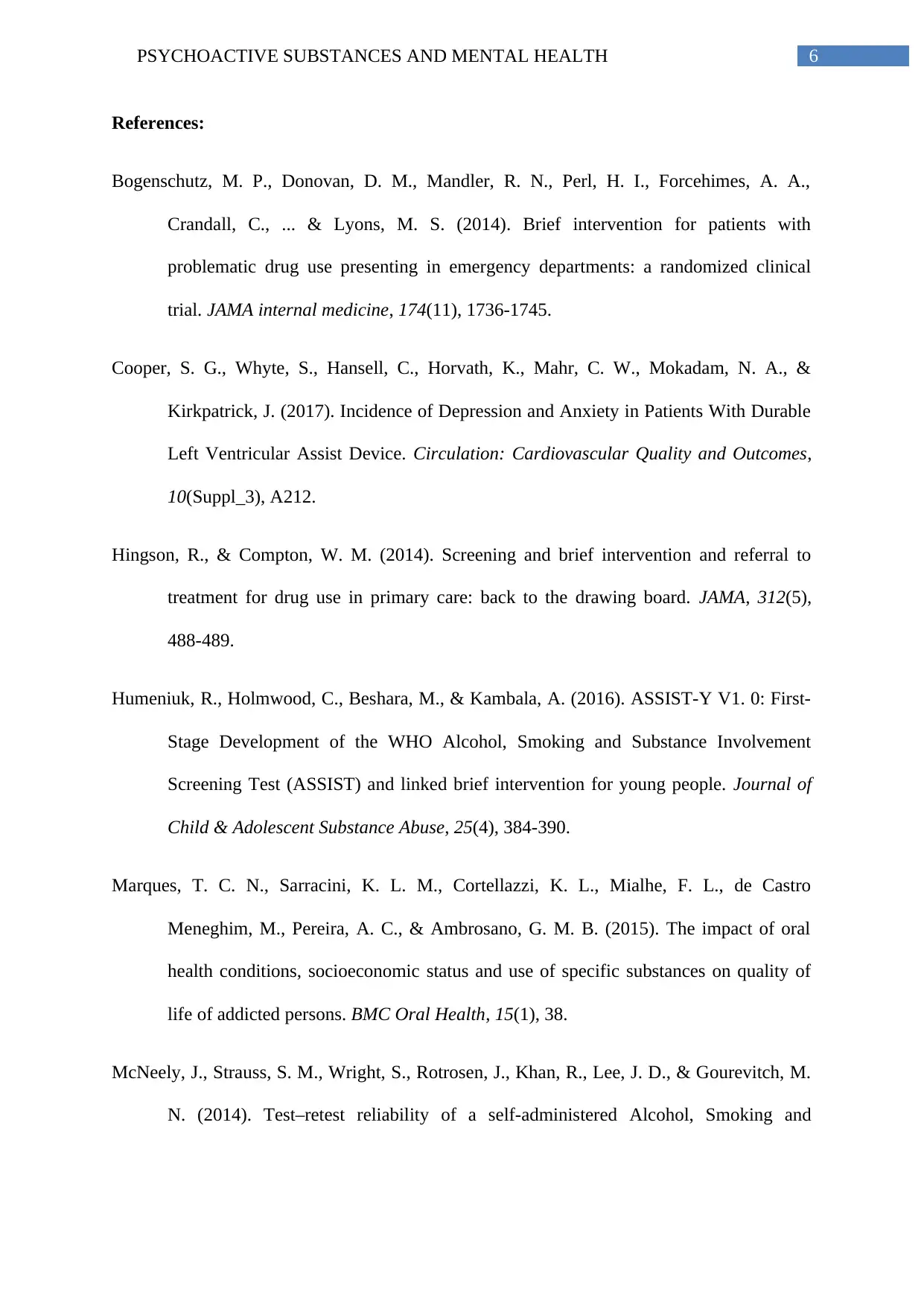
6PSYCHOACTIVE SUBSTANCES AND MENTAL HEALTH
References:
Bogenschutz, M. P., Donovan, D. M., Mandler, R. N., Perl, H. I., Forcehimes, A. A.,
Crandall, C., ... & Lyons, M. S. (2014). Brief intervention for patients with
problematic drug use presenting in emergency departments: a randomized clinical
trial. JAMA internal medicine, 174(11), 1736-1745.
Cooper, S. G., Whyte, S., Hansell, C., Horvath, K., Mahr, C. W., Mokadam, N. A., &
Kirkpatrick, J. (2017). Incidence of Depression and Anxiety in Patients With Durable
Left Ventricular Assist Device. Circulation: Cardiovascular Quality and Outcomes,
10(Suppl_3), A212.
Hingson, R., & Compton, W. M. (2014). Screening and brief intervention and referral to
treatment for drug use in primary care: back to the drawing board. JAMA, 312(5),
488-489.
Humeniuk, R., Holmwood, C., Beshara, M., & Kambala, A. (2016). ASSIST-Y V1. 0: First-
Stage Development of the WHO Alcohol, Smoking and Substance Involvement
Screening Test (ASSIST) and linked brief intervention for young people. Journal of
Child & Adolescent Substance Abuse, 25(4), 384-390.
Marques, T. C. N., Sarracini, K. L. M., Cortellazzi, K. L., Mialhe, F. L., de Castro
Meneghim, M., Pereira, A. C., & Ambrosano, G. M. B. (2015). The impact of oral
health conditions, socioeconomic status and use of specific substances on quality of
life of addicted persons. BMC Oral Health, 15(1), 38.
McNeely, J., Strauss, S. M., Wright, S., Rotrosen, J., Khan, R., Lee, J. D., & Gourevitch, M.
N. (2014). Test–retest reliability of a self-administered Alcohol, Smoking and
References:
Bogenschutz, M. P., Donovan, D. M., Mandler, R. N., Perl, H. I., Forcehimes, A. A.,
Crandall, C., ... & Lyons, M. S. (2014). Brief intervention for patients with
problematic drug use presenting in emergency departments: a randomized clinical
trial. JAMA internal medicine, 174(11), 1736-1745.
Cooper, S. G., Whyte, S., Hansell, C., Horvath, K., Mahr, C. W., Mokadam, N. A., &
Kirkpatrick, J. (2017). Incidence of Depression and Anxiety in Patients With Durable
Left Ventricular Assist Device. Circulation: Cardiovascular Quality and Outcomes,
10(Suppl_3), A212.
Hingson, R., & Compton, W. M. (2014). Screening and brief intervention and referral to
treatment for drug use in primary care: back to the drawing board. JAMA, 312(5),
488-489.
Humeniuk, R., Holmwood, C., Beshara, M., & Kambala, A. (2016). ASSIST-Y V1. 0: First-
Stage Development of the WHO Alcohol, Smoking and Substance Involvement
Screening Test (ASSIST) and linked brief intervention for young people. Journal of
Child & Adolescent Substance Abuse, 25(4), 384-390.
Marques, T. C. N., Sarracini, K. L. M., Cortellazzi, K. L., Mialhe, F. L., de Castro
Meneghim, M., Pereira, A. C., & Ambrosano, G. M. B. (2015). The impact of oral
health conditions, socioeconomic status and use of specific substances on quality of
life of addicted persons. BMC Oral Health, 15(1), 38.
McNeely, J., Strauss, S. M., Wright, S., Rotrosen, J., Khan, R., Lee, J. D., & Gourevitch, M.
N. (2014). Test–retest reliability of a self-administered Alcohol, Smoking and
Paraphrase This Document
Need a fresh take? Get an instant paraphrase of this document with our AI Paraphraser

7PSYCHOACTIVE SUBSTANCES AND MENTAL HEALTH
Substance Involvement Screening Test (ASSIST) in primary care patients. Journal of
substance abuse treatment, 47(1), 93-101.
Palfai, T. P., Tahaney, K., Winter, M., & Saitz, R. (2016). Readiness-to-change as a
moderator of a web-based brief intervention for marijuana among students identified
by health center screening. Drug and alcohol dependence, 161, 368-371.
Patston, L. L., Travers, K. A., & Newcombe, D. A. (2017). The Acceptability and Feasibility
of Screening for Alcohol and Drug Misuse in a Hospital Emergency Department.
Addictive disorders & their treatment, 16(3), 111.
Rahm, A. K., Boggs, J. M., Martin, C., Price, D. W., Beck, A., Backer, T. E., & Dearing, J.
W. (2015). Facilitators and barriers to implementing Screening, Brief Intervention,
and Referral to Treatment (SBIRT) in primary care in integrated health care settings.
Substance abuse, 36(3), 281-288.
Saitz, R., Palfai, T. P., Cheng, D. M., Alford, D. P., Bernstein, J. A., Lloyd-Travaglini, C.
A., ... & Samet, J. H. (2014). Screening and brief intervention for drug use in primary
care: the ASPIRE randomized clinical trial. Jama, 312(5), 502-513.
Suffoletto, B., Kristan, J., Chung, T., Jeong, K., Fabio, A., Monti, P., & Clark, D. B. (2015).
An interactive text message intervention to reduce binge drinking in young adults: A
randomized controlled trial with 9-month outcomes. PloS one, 10(11), e0142877.
Wolff, N., & Shi, J. (2015). Screening for substance use disorder among incarcerated men
with the Alcohol, Smoking, Substance Involvement Screening Test (ASSIST): A
comparative analysis of computer-administered and interviewer-administered
modalities. Journal of substance abuse treatment, 53, 22-32.
Substance Involvement Screening Test (ASSIST) in primary care patients. Journal of
substance abuse treatment, 47(1), 93-101.
Palfai, T. P., Tahaney, K., Winter, M., & Saitz, R. (2016). Readiness-to-change as a
moderator of a web-based brief intervention for marijuana among students identified
by health center screening. Drug and alcohol dependence, 161, 368-371.
Patston, L. L., Travers, K. A., & Newcombe, D. A. (2017). The Acceptability and Feasibility
of Screening for Alcohol and Drug Misuse in a Hospital Emergency Department.
Addictive disorders & their treatment, 16(3), 111.
Rahm, A. K., Boggs, J. M., Martin, C., Price, D. W., Beck, A., Backer, T. E., & Dearing, J.
W. (2015). Facilitators and barriers to implementing Screening, Brief Intervention,
and Referral to Treatment (SBIRT) in primary care in integrated health care settings.
Substance abuse, 36(3), 281-288.
Saitz, R., Palfai, T. P., Cheng, D. M., Alford, D. P., Bernstein, J. A., Lloyd-Travaglini, C.
A., ... & Samet, J. H. (2014). Screening and brief intervention for drug use in primary
care: the ASPIRE randomized clinical trial. Jama, 312(5), 502-513.
Suffoletto, B., Kristan, J., Chung, T., Jeong, K., Fabio, A., Monti, P., & Clark, D. B. (2015).
An interactive text message intervention to reduce binge drinking in young adults: A
randomized controlled trial with 9-month outcomes. PloS one, 10(11), e0142877.
Wolff, N., & Shi, J. (2015). Screening for substance use disorder among incarcerated men
with the Alcohol, Smoking, Substance Involvement Screening Test (ASSIST): A
comparative analysis of computer-administered and interviewer-administered
modalities. Journal of substance abuse treatment, 53, 22-32.

8PSYCHOACTIVE SUBSTANCES AND MENTAL HEALTH
World Health Organization. (2016). The ASSIST screening test version 3.0 and feedback
card.
World Health Organization. (2016). The ASSIST screening test version 3.0 and feedback
card.
1 out of 9
Your All-in-One AI-Powered Toolkit for Academic Success.
+13062052269
info@desklib.com
Available 24*7 on WhatsApp / Email
![[object Object]](/_next/static/media/star-bottom.7253800d.svg)
Unlock your academic potential
© 2024 | Zucol Services PVT LTD | All rights reserved.


